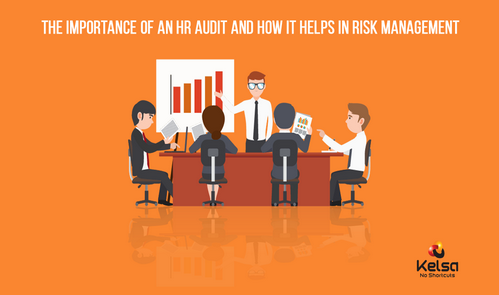The Importance of An HR Audit And How it Helps in Risk Management

Assessing systemic risks and defining mitigation strategies is an essential activity that needs to be carried out in all organisations. And, particularly within functions such as Human Resources, periodic process audits can help to not just eliminate innate organisational threats, but also align the function with future growth objectives.
Aligning HR audits to future organisational goals
Audit and risk management processes within the HR function help drive greater effectiveness and secure organisational interests. A detailed analysis of risks through a well-defined audit process helps HR leaders set effective controls, deliver better on business effectiveness, and align the function to enable organisational growth drivers.
Broadly, a well-executed HR audit is designed to offer a comprehensive view of all HR policies, practices and procedures that are practised within the organisation and involves a detailed scrutiny and review of documents, templates and processes as managed by the HR team, as well as process deployment and interfaces established within and outside the organisation.
However, for HR audit processes to be truly effective, they need to go beyond the routine scrutiny and review of processes and templates. Instead, they will need to be designed to look further – beyond the obvious directions, and drive greater definition on future state processes.
This will mean that the audit exercises stay focused on
- mapping and defining current HR systems and processes with desired systems and practices,
- drawing a detailed analysis and documentation of existing gaps and future goals, and
- defining a robust road map that helps the HR function plan and prepare to embracing and delivering on these goals.
But given that audit processes can even normally seen time consuming and expensive, how can functional heads be encouraged to embark on audit exercises that push for greater alignment with the organisation’s future goals? And how are they to reach out to their teams and other functional heads to solicit their support, co-operation and commitment in ensuring a forward looking audit approach?
Committing to a future-focused HR Audit processes to the future
Before embarking on the HR audit exercise, it is vital that functional leaders think about key functional goals that have been set for the near and long term, and prioritise on areas where they would clearly like to drive high levels of efficacy.
At this point, it would also be useful to involve other internal stakeholders to gather their input and perspective on areas where process gaps and failures are currently perceived, and define the nature of future state processes and service delivery. These steps will help the audit team develop a broad understanding of planned and emerging organisational goals, and directions needed within the HR process and service delivery framework to support them.
The Audit team then embarks on a detailed scrutiny and verification of all formal and informal practices/ procedures and record their findings on existing operations, policies and processes. They compare their findings against the desired organisation goals and suggest areas for action, improvement and review.
While reporting on the standard areas such as process controls and compliance measures, the ambit of the audit exercise will include measures of –
- efficacy of current policies and procedures, and measures to improve quality and effectiveness to support future goals
- customer centricity and alignment with business intent within all HR processes
- the need for new policies, procedures and practices to minimise future risks and ensure greater savings
- extent of transparency and diligence needed across business and HR processes
- additional training and communication needs to help sensitise the HR team as well as employees to future state processes
Planning forward
At the end of the day, success in implementation of the audit findings will rest with the organisation’s leadership. Leaders will need to understand that an effective plan of action will drive greater effectiveness not just within the HR function, but across the organisation. This means that steps will need to be taken to swiftly prioritise areas for action, plan, implement and institutionalise changes within the HR processes.
In addition, steps need to be taken to ensure complete ownership on forward-looking strategies and systematic follow-through on actions, and a clear road map drawn along precise measures to achieve milestones. Process benchmarks will also be set to identify, anticipate and address bottlenecks, and deploy mitigating actions.
Finally, it would be very important to ensure employees are completely involved in this journey – that the strategy for growth is made visible to them, and they understand and appreciate how people processes are being aligned to meet future organisational goals. This will ensure better buy-in across groups and secure long term organisational success.
The Importance of An HR Audit And How it Helps in Risk Management

Assessing systemic risks and defining mitigation strategies is an essential activity that needs to be carried out in all organisations. And, particularly within functions such as Human Resources, periodic process audits can help to not just eliminate innate organisational threats, but also align the function with future growth objectives.
Aligning HR audits to future organisational goals
Audit and risk management processes within the HR function help drive greater effectiveness and secure organisational interests. A detailed analysis of risks through a well-defined audit process helps HR leaders set effective controls, deliver better on business effectiveness, and align the function to enable organisational growth drivers.
Broadly, a well-executed HR audit is designed to offer a comprehensive view of all HR policies, practices and procedures that are practised within the organisation and involves a detailed scrutiny and review of documents, templates and processes as managed by the HR team, as well as process deployment and interfaces established within and outside the organisation.
However, for HR audit processes to be truly effective, they need to go beyond the routine scrutiny and review of processes and templates. Instead, they will need to be designed to look further – beyond the obvious directions, and drive greater definition on future state processes.
This will mean that the audit exercises stay focused on
- mapping and defining current HR systems and processes with desired systems and practices,
- drawing a detailed analysis and documentation of existing gaps and future goals, and
- defining a robust road map that helps the HR function plan and prepare to embracing and delivering on these goals.
But given that audit processes can even normally seen time consuming and expensive, how can functional heads be encouraged to embark on audit exercises that push for greater alignment with the organisation’s future goals? And how are they to reach out to their teams and other functional heads to solicit their support, co-operation and commitment in ensuring a forward looking audit approach?
Committing to a future-focused HR Audit processes to the future
Before embarking on the HR audit exercise, it is vital that functional leaders think about key functional goals that have been set for the near and long term, and prioritise on areas where they would clearly like to drive high levels of efficacy.
At this point, it would also be useful to involve other internal stakeholders to gather their input and perspective on areas where process gaps and failures are currently perceived, and define the nature of future state processes and service delivery. These steps will help the audit team develop a broad understanding of planned and emerging organisational goals, and directions needed within the HR process and service delivery framework to support them.
The Audit team then embarks on a detailed scrutiny and verification of all formal and informal practices/ procedures and record their findings on existing operations, policies and processes. They compare their findings against the desired organisation goals and suggest areas for action, improvement and review.
While reporting on the standard areas such as process controls and compliance measures, the ambit of the audit exercise will include measures of –
- efficacy of current policies and procedures, and measures to improve quality and effectiveness to support future goals
- customer centricity and alignment with business intent within all HR processes
- the need for new policies, procedures and practices to minimise future risks and ensure greater savings
- extent of transparency and diligence needed across business and HR processes
- additional training and communication needs to help sensitise the HR team as well as employees to future state processes
Planning forward
At the end of the day, success in implementation of the audit findings will rest with the organisation’s leadership. Leaders will need to understand that an effective plan of action will drive greater effectiveness not just within the HR function, but across the organisation. This means that steps will need to be taken to swiftly prioritise areas for action, plan, implement and institutionalise changes within the HR processes.
In addition, steps need to be taken to ensure complete ownership on forward-looking strategies and systematic follow-through on actions, and a clear road map drawn along precise measures to achieve milestones. Process benchmarks will also be set to identify, anticipate and address bottlenecks, and deploy mitigating actions.
Finally, it would be very important to ensure employees are completely involved in this journey – that the strategy for growth is made visible to them, and they understand and appreciate how people processes are being aligned to meet future organisational goals. This will ensure better buy-in across groups and secure long term organisational success.




